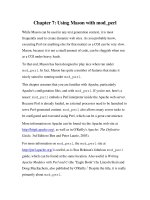Exercise dbms chapter 7 database recovery techniques
Bạn đang xem bản rút gọn của tài liệu. Xem và tải ngay bản đầy đủ của tài liệu tại đây (5.1 MB, 4 trang )
Subject: Database Management Systems (CO3021)
Semester 1, 2020-2021
Chapter 7: Database Recovery Techniques
Question 7.1. Describe some non-catastrophic failures and catastrophic failures. Introduce some
approaches to deal with these failures.
Question 7.2. State the purposes of database recovery from transaction failures.
Question 7.3. What are transaction commit points? Why are they important?
Question 7.4. What are checkpoints? Why are they important? What is fuzzy checkpointing?
Question 7.5. Distinguish deferred update with immediate update.
Question 7.6. What are the before image (BFIM) and after image (AFIM) of a data item? What is the
difference between in-place updating and shadowing, with respect to their handling of BFIM and AFIM?
Question 7.7. Describe UNDO and REDO operations. Distinguish them from transaction rollback and rollforward.
Question 7.8. Describe the write-ahead logging protocol.
Question 7.9. Describe the policies when a page from the database cache can be written to disk:
steal/no-steal, force/no-force.
Question 7.10. Discuss the deferred update technique of recovery. What are the advantages and
disadvantages of this technique? Why is it called the NO-UNDO/REDO method?
Question 7.11. Discuss the immediate update recovery technique in both single-user and multiuser
environments. What are the advantages and disadvantages of immediate update? What is the
difference between the UNDO/REDO and the UNDO/NO-REDO algorithms for recovery with immediate
update?
Question 7.12. Describe the shadow paging recovery technique. Under what circumstances does it not
require a log? Why is it called a NO-UNDO/NO-REDO method?
Question 7.13. Describe the three phases of the ARIES recovery method.
Question 7.14. Describe the two-phase commit protocol for multidatabase transactions.
Question 7.15. Discuss how disaster recovery from catastrophic failures is handled.
Question 7.16. Given a system log as follows. Suppose that:
(1). the system crashes before the [read_item, T3, A] entry is written to the log
(2). the system crashes before the [write_item, T2, D, 25, 26] entry is written to the log.
Describe the recovery process for each case.
1
Question 7.17. Given the log corresponding to a particular schedule at the point of a system crash for
four transactions T1, T2, T3, and T4.
Describe the recovery process from the system crash. Specify which transactions are rolled back, which
operations in the log are redone and which (if any) are undone, and whether any cascading rollback
takes place.
(1). use the deferred update protocol with checkpointing
(2). use the immediate update protocol with checkpointing
2
Question 7.18. Given the execution of the transactions in (a), (b), and (c) as follows. For each execution,
describe the recovery process after the system crashes using the deferred update protocol with
checkpointing. Repeat the question with the immediate update protocol.
(a).
(b).
(c).
Question 7.19. Given the log when the system crashes, the Transaction and Dirty Page tables at the
checkpoint as follows. Describe the recovery process using ARIES.
The log:
3
The Transaction Table and Dirty Page Table:
Question 7.20. Given the log when the system crashes as follows. Describe the recovery process using:
(1). deferred update, (2). immediate update, and (3). ARIES methods.
4









